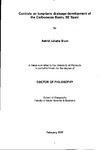Controls on long-term drainage development of the Carboneras Basin, SE Spain
| dc.contributor.author | Blum, Astrid Juliette | |
| dc.contributor.other | School of Geography, Earth and Environmental Sciences | en_US |
| dc.date.accessioned | 2013-10-18T10:11:18Z | |
| dc.date.available | 2013-10-18T10:11:18Z | |
| dc.date.issued | 2007 | |
| dc.identifier | NOT AVAILABLE | en_US |
| dc.identifier.uri | http://hdl.handle.net/10026.1/2220 | |
| dc.description.abstract |
The impact of external and internal controls on long-term drainage evolution can play an important role in the research on global changes. For longer term controls such as tectonics and climate this necessitates the use of a long time-scale such as the Plio/Pleistocene, and the integration of both geological and geomorphological data. This thesis uses data from Plio/Pleistocene alluvial deposits (deltaic and fluvial) of the Carboneras Basin in southeast Spain to address these issues. The Carboneras Basin, an intermontane basin of the Belie Cordillera, was one of the last of a series of sedimentary basins which underwent transition from marine to continental conditions during the Plio/Pleistocene in this region. The basin is still tectonically active, controlled by surface uplift of the basin, differential uplift of the Sierra Alhamilla/Cabrera mountain range and activity along the 40 km long strike-slip Carboneras Fault. This study follows the evolution of a basin-scale drainage network using a multidisciplinary approach to determine the long-term influences of extrinsic and intrinsic controls on the drainage system of the Carboneras basin. Geological and geomorphological data is evaluated to trace the depositional and erosional record of the drainage systems. Palaeogeographic reconstruction of the marine and deltaic Pliocene deposits revealed large fan delta sediments in the northern part of the Carboneras Basin. Detailed field investigations discovered a 'Gilbert' type delta, suggesting the occurrence of a steep palaeocliff created by vertical movements along the Carboneras Fault Zone. Palaeocurrent measurements suggest three fluvial inputs from N-NW directions into the Carboneras Basin: the Rambla de Lucainena, Rambla de Ios Feos and Rio Gafares. The Rio Gafares, responsible for the Gilbert type fan delta, was the biggest and probably most important drainage system in terms of sediment supply to the basin during the Upper Pliocene. After a fall in sea level the transverse, antecedent Rio Gafares evolved developing a staircase of straths and terraces. Four terrace levels have been assigned for the Rio Gafares. Detailed investigations of river terrace deposits established an ongoing connection between the adjacent Sorbas Basin and the Carboneras drainage until the Late Pleistocene. A probable river capture of the Rio Gafares finally limited the catchment size of the river and decreased the sediment supply to the Carboneras Basin. This can be seen in the provenance distribution and the lack of Amphibole-mica-schist, which was used as a marker clast for Nevado-Filabride component, derived from the Sorbas Basin. The terraces of the Gafares system are mainly controlled by tectonically driven uplift of the Sierra Cabrera. Additional to the north-south draining Gafares River a strike parallel river, the Rio Alias, developed south of the mountain front by the confluence of the Rambla de Lucainena and Rambla de los Feos. Four Quaternary terrace levels have been determined for the Rio Alias and have been age correlated to terrace levels of the Sorbas Basin, using pedogenic calcrete stages. A combined examination of the palaeoterrace distribution and modern river network has identified post sedimentary displacement of the river channel across the Carboneras Fault Zone. Three fault strands have been recognized and lateral and vertical displacement along the strike-slip fault has been demonstrated. Mapping fan delta conglomerates revealed vertical movement since the Late Pliocene. The lateral component, calculated from offset terrace conglomerates, has an estimated strike-slip movement of 14 mm I aˉ¹ since the Upper Pleistocene. This study has established the drainage history of the Carboneras Basin indicating the significance of river capture and river re-routing in sediment supply to the basin. The occurrence of four aggradational periods associated with the terrace levels appear to be climate controlled. However the overall incision is a response to uplift. As this uplift was differential, leading to enhanced regional gradients between sedimentary basins, the uplift was indirectly key to re-routing major sediment transport routes (the main rivers) both within and between sedimentary basins, through river capture. | en_US |
| dc.language.iso | en | en_US |
| dc.publisher | University of Plymouth | en_US |
| dc.title | Controls on long-term drainage development of the Carboneras Basin, SE Spain | en_US |
| dc.type | Thesis | |
| dc.identifier.doi | http://dx.doi.org/10.24382/3932 | |
| dc.identifier.doi | http://dx.doi.org/10.24382/3932 |
Files in this item
This item appears in the following Collection(s)
-
01 Research Theses Main Collection
Research Theses Main


